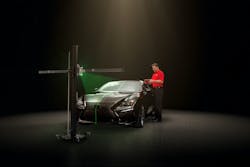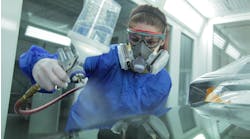March 14, 2019—Every once in a while, Ed Sprigler receives a phone call, as late as 9 p.m., from colleagues who have questions about the cameras associated with advanced driver-assistance systems.
But Sprigler isn’t annoyed by such calls. After all, as the vice president of strategic initiatives at Safelite AutoGlass, Sprigler knows the dangers associated with an uncalibrated ADAS system.
That’s why he’s training technicians to be an expert in integrating repairs associated with ADAS technology.
“It has been a massive growth requirement for us,” the Safelite executive said, “to bring our associates up to speed, to create, in essence, a whole new business line, in order to appropriately service all stakeholders.”
According to I-CAR research, 86 percent of vehicles today have some form of ADAS technology, which aids with driving issues such as blind spots or traffic sign recognition. And, in Sprigler’s experience, roughly 5 percent of vehicles from model year 2013—or, 1 out of every 20 vehicles—require ADAS recalibration after a windshield is replaced (different manufacturers require either a static recalibration or a dynamic recalibration). Fast forward to 2019, and 1 out of every 2 vehicles require such recalibration, as specified by most OEM procedures.
Sprigler’s research has indicated to him that, when a windshield is replaced on today’s vehicles featuring ADAS systems, it could result in a slight difference in the angle of where that glass is sitting in relation to a camera lense. And, as he notes, just 1 degree of camera difference, when a vehicle is moving at 60 miles per hour, equates to 30 yards per second.
“If your vehicle’s systems don’t realize exactly where you’re sitting in relation to space,” Sprigler said, “the vehicle might not react to protect you from yourself.”
Compounding that problem is the fact that, in 2019, many drivers have come to rely on features provided by ADAS systems.
“I’ll frame it like this,” Sprigler said. “We’re unfortunately probably more distracted than we ever have been as drivers. Think about the distractions that exist for us today—frankly, vehicles are faster, they have better suspension, tires are better, we’ve got a lot of vehicles on the road. … And, there’s a lot of activity going on in these vehicles; we’re distracted.
“So, a vehicle that doesn’t have its safety systems running at an optimized level, there’s an added risk. When those systems are potentially not at their peak performance, you’re going to run the risk of more crashes.”
According to the United States Department of Transportation, in 2016 alone, 37,461 people died in vehicle crashes. ADAS systems can, theoretically, help reduce that number.
That’s why Sprigler and Safelite are acting with such urgency when it comes to teaching their technicians how to properly recalibrate ADAS systems.
“It’s not optional,” Sprigler said. “You have to do it.”




